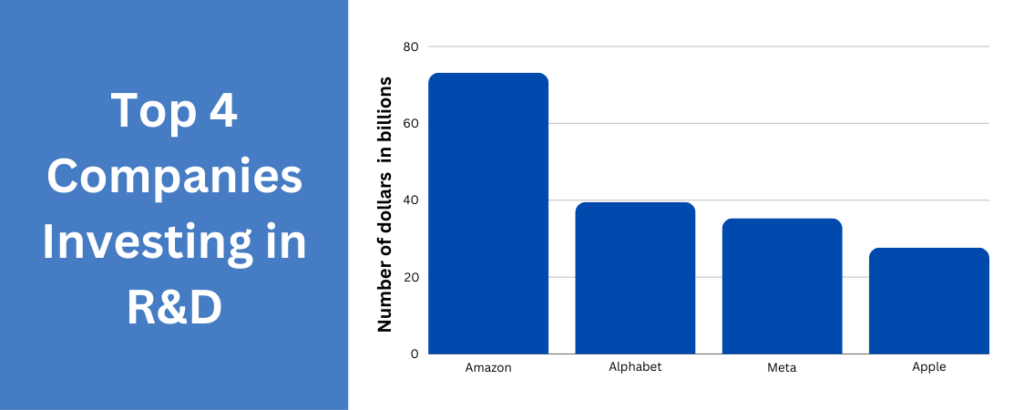Research and development, or R&D, is a key activity that companies undertake to drive innovation and growth. Through strategic R&D investments, firms seek to gain competitive advantages, fuel expansion into new markets, and future-proof their business in dynamic industries. This article will explore the reason why companies invest in R&D.
What Is R&D And Why Do Companies Invest In It?
Research and development, commonly referred to as R&D, involves activities companies undertake to innovate and develop new products, services, and processes. There are a few key reasons why companies invest substantial resources into R&D.
Primarily, investing in R&D helps companies gain competitive advantages in the marketplace. By innovating new offerings, companies can differentiate themselves from competitors and meet emerging customer needs. R&D also allows firms to renew their product pipelines, as patents expire and mature products decline. This ensures long-term growth and profitability. Additionally, R&D opens doors to entirely new markets and industries, fueling expansion opportunities for companies.
R&D grants companies more control over their technologies, intellectual property, and supply chains compared to outsourcing or acquisition options. Internal innovation better aligns with corporate strategies compared to relying solely on external innovation. R&D also supports companies in adapting to changes in technology and customer behavior that could disrupt existing business models if left unaddressed. Making strategic investments in developing a culture of innovation helps future-proof companies.
What Are The Main Types Of R&D?

There are two broad categories of R&D: basic research and applied research. Basic research involves experimental investigation to gain more comprehensive scientific knowledge without a specific commercial goal. It expands the boundaries of understanding and often has a long-term orientation. In contrast, applied research focuses on gaining knowledge to determine possible uses for new inventions or discoveries that can be developed further into commercial applications, products, and processes.
Within applied research there are subcategories. Experimental development aims to attain new materials, devices, products, and processes, as well as improvements. Some key examples are prototype development, design improvement, and process improvement involving new technology use. Developmental research applies knowledge gained from research to practical solutions, such as developing new systems and services. Much industrial research and capital investment falls into the applied research spectrum.
R&D may also be categorized as industrial research versus academic research. Industrial research comprises activities within company boundaries, while academic research occurs chiefly at universities and other research institutions. Academic research often provides the foundations for industrial research to build commercial applications. Both spheres play vital roles in advancing science and technology.
How Do Companies Budget For And Fund Their R&D Activities?

Undertaking R&D activities requires significant financial investments, which companies budget for based on strategic priorities and return expectations. Most large corporations devote several percent of annual revenues to R&D budgets. Budgets are determined through planning processes accounting for timelines and milestones associated with project pipelines. Budgets are then allocated across the various R&D departments and projects in progress.
In terms of funding, companies primarily self-fund R&D through cash flows from operations. Some firms take on debt to finance more ambitious initiatives with potentially large long-term payoffs. Companies may also sell R&D tax credits from governments in certain jurisdictions to recover a portion of allowable R&D expenditures and partially offset costs. Another approach is forming collaborative consortiums where costs and risks are shared among industry players pursuing grouped research goals. Occasionally, external venture capital investments supplement internal budgets for high-risk, high-reward technology exploration. By diversifying funding approaches, firms can pursue broader R&D agendas.
How Do Companies Protect Innovations From Competitors?
Protecting the fruits of R&D spending motivates prudent intellectual property (IP) management by companies. Patents, trademarks, industrial designs, and copyrights provide legal protections for inventions, brands, and confidential information that could be threatened by free-riding competitors otherwise.
Companies devote significant resources to the patenting process; carefully crafting claims, shepherding applications, and monitoring expiry dates. Defensive publishing blunts potential IP risks if an idea becomes publicly known before filing. Trade secrets and non-disclosure agreements supply backup routes if full patentability proves elusive for some innovations. Firms also vigilantly police IP protection by legally addressing suspected infringements or counterfeiting quickly. Strong brands and crafting competitive differentiation further buttress innovations’ commercial value beyond legal safeguards alone as well.
Globalization intensifies the importance of multilayered IP safeguarding as piracy and imitation spread internationally. While vigilant protectionism secures rewards from innovation, striking a balance avoiding excessive hindrance of follow-on research also remains crucial for technological progress overall. Careful strategy differentiates reasonable stewardship from counterproductive over-enforcement.
How Does R&D Impact Financial Performance?

While massive upfront R&D spending seems a burden on income statements, its long-term contributions to performance should be the focus. Creating valuable innovations bolstering corporate competitiveness, market caps steadily outpace peers lacking equivalent commitments to internal technology development and renewal. Financial outcomes regularly justify prudent R&D budgets managed strategically.
Robust R&D helps strengthen operating margins through economies of scale in production. New patent royalty income and reduced dependency on purchased technologies all enhance profit conversion rates over decades. Even failed projects occasionally uncover strategically important knowledge which spawns later commercial successes indirectly. Consistent R&D drives sustainable competitive advantages far eclipsing its amortized costs when rolled into multi-year returns on invested capital as intended. Shareholder value uplifts accordingly through gains in enterprise value multiples over prolonged periods. Perhaps most importantly, R&D differentiates thriving enterprises across generations.
Conclusion | Why Do Companies Invest in R&D?
In today’s fast-paced business environment, R&D is crucial for companies who want to stay ahead of the competition and adapt to changing needs and technologies. While R&D requires significant upfront costs, companies that manage their investments strategically can enjoy strong financial returns in the long run through new products, processes, and market opportunities. By engaging in purposeful R&D efforts aligned with corporate strategy, firms aim to sustain competitive differentiation and ensure their continued success for many years to come.








